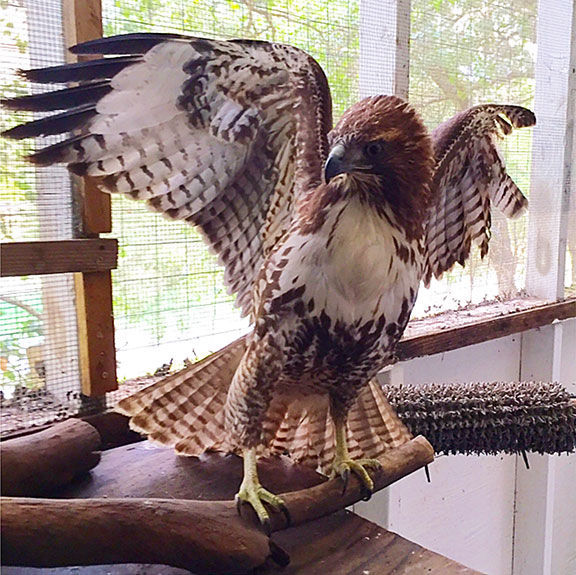Very early on a dark, cold morning in late December in Los Banos, a duck hunter was preparing for the day’s activities when his golden retriever came upon an injured hawk and alerted the hunter.
Returning later after the day had lightened, the man found the bird still on the ground, still unable to fly away. Because the hunter’s son had once been a volunteer at the Wildlife Education and Rehabilitation Center in Morgan Hill, they were familiar with WERC’s commitment to the care and treatment of injured and orphaned native wildlife. With the help of his friends, the hunter-rescuer placed a blanket over the hawk and carefully carried it back to his truck, where he had a dog crate that could confine the hawk until it could be transferred to WERC.
At WERC, the juvenile hawk’s examination showed that it was missing the phalanges, i.e., finger bones, and the vital primary feathers on its left wing.
To prevent infection of the open wound on the wing and to relieve discomfort, clinic volunteers administered daily antibiotics and pain medication. Though the wound is healing, the hawk’s prognosis is still guarded and we will need to wait until at least spring to see if the primary feathers grow out and if the hawk is able to fly well in the 100-foot aviary. If all goes as well as we are hoping, the hawk will be released to a suitable habitat in early summer.
Because red-tailed hawks are colloquially known in the United States as “chickenhawks”, we’ve decided to nickname this hawk, “Henery Hawk”, after the Looney Tunes baby hawk cartoon character.
Doesn’t the hawk in this photo look like he’s saying Henery’s catch-phrase, “Are you comin’ quietly, or do I have to muss ya up!?” The cartoon Henery’s song, “Chicken Hawk, gettin’ hungry, Chicken Hawk, gettin’ hungry…I’ve got something for your appetite. There’s so many things that you could eat” is appropriate to this real-life hawk because for over one week he had refused to dine any of the food we proffered.
Volunteers tried to tempt him with an assortment of appetizing rodents and quail, but he turned his beak up at everything. We thought that maybe he had already developed epicurean preferences for wild prey.
In the meantime, he needed sustenance to keep up his strength and aid recovery, so he was force-fed several times a week, a necessary procedure but not the most pleasant experience for any animal.
So it was with gratifying relief that one morning we found that he had finally opted to eat on his own. And hungrily! From then on, he devoured 8 to 10 rodents every day. A real-life red-tailed hawk’s actual prey is voles, mice, wood rats, rabbits and hares, ground squirrels, snakes and carrion. The hawks also eat birds, including pheasants, quail, starlings, and blackbirds—but note that it rarely preys on chickens…or ducks.








